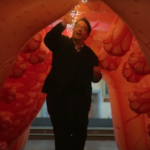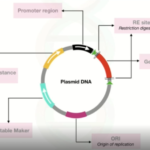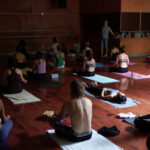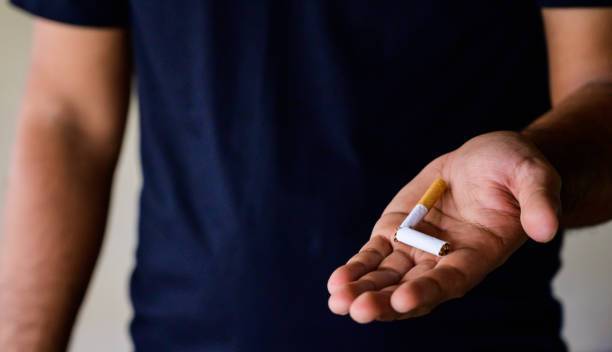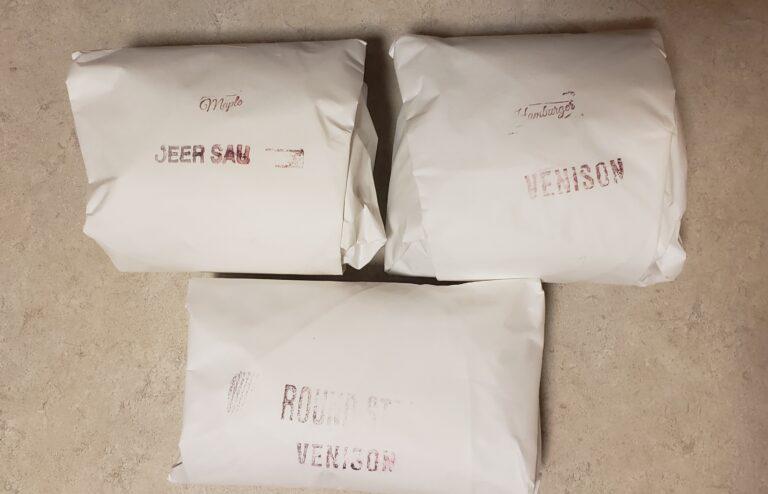Heading out the door? Read this article on the new Outside+ app available now on iOS devices for members!
Download the app.
When you’re challenged to make space for your yoga practice, chances are you crave something that delivers enhanced strength and flexibility and some measure of mindful awareness all at once. This 20-minute power yoga flow delivers all three by relying on blocks to help engage muscle groups you might not normally engage or connect with.
You may be accustomed to relying on blocks to close the distance between the mat and your body—and they are amazing at doing exactly that. But by creatively incorporating blocks into your practice in ways that go beyond their common usage, you can help you engage muscle groups that tend to be overlooked and unlock new dimensions of strength, flexibility, and awareness.
How Using Blocks Can Change Your Experience of Common Poses
Most yoga teachers are pretty diligent about saying “spread your fingers” and “push into your fingertips and knuckles” to help ensure not all of your body weight is collapsing onto your wrists.
But when you’re using blocks beneath your hands, you have no choice but to make those adjustments to your practice. You almost need to grip the block, so it teaches you to use those hand muscles and take the weight off of your wrists. You’ll feel the activation in your shoulders in ways that go beyond closing the gap between your body and the floor. In addition, you’ll learn how to make adjustments that more evenly distribute your body weight, a mindful approach that can foster a lasting muscle memory and protect your joints in your future practice.
In Downward Dog (Adho Mukha Svanasana), placing blocks beneath your hands allows you a little more space and a lift through the arms. Notice how that shifts your pelvis further back. What happens when you’re able to get your heels a little bit closer to the mat? Where’s the activation felt in your shoulders?
When you transfer your body weight into one hand in Side Plank Pose (Vasisthasana), does all of your body weight now go into your pinky finger versus your thumb versus your palm? Even noticing what it feels like to have your elbows lifted off the mat in Child’s Pose (Balasana) can be interesting. These are just some of the benefits of intentionally practicing with blocks even in a 20-minute power yoga flow.
20-Minute Power Yoga Flow With Blocks
This dynamic 20-minute power yoga practice is tailored to students with some yoga experience who are familiar with the basic alignment of each pose. It goes beyond building strength and enhancing flexibility to offer a unique opportunity for self-awareness. By challenging yourself mentally and physically, you’ll expand your practice and cultivate a more resilient mindset.
You’ll want to have two blocks at the ready. The most stable position for the blocks is on the lowest level, although you can adjust the blocks as needed.
Cat-Cow with Blocks
Begin with Cat-Cow using the blocks on the lowest level beneath your hands. Place your thumbs and little fingers on the outer edges of the blocks and your three middle fingers on the tops. Align your hands directly beneath or slightly in front of your shoulders, with your hips stacked above your knees.
Inhale and arch your back in Cow Pose. Exhale and round your back in Cat Pose. Breathe into this space as you repeat the movement a couple of times. The blocks offer more space for you to stretch, especially in your upper back. Return to a neutral tabletop position.
Half Moon Variation
From Tabletop, extend your right leg straight behind you, with your foot about the same height as your hips. Shift your weight into your left hand and turn your chest and hips toward the side wall. Reach your right arm toward the ceiling in a kneeling version of Half Moon Pose. Try to lift your right leg a little higher. Using the blocks requires more engagement in your glutes.
Low Lunge with Blocks
Carefully return your right hand to the block and step your right foot forward between the blocks at the top of the mat in a Low Lunge with your hands or fingertips on the blocks. This allows you to find stability through your arms as you sink your hips forward and down to stretch your hip flexors.
Plank Pose Variation With Blocks
From Low Lunge, keep your palms on the blocks as you step your right foot back into Plank Pose. Exhale as you shift your hips forward, lower your knees, and bend your elbows halfway into a modified Plank Pose.
Child’s Pose With Blocks
Transition into a variation of Child’s Pose by shifting your hips back and keeping your hands on the blocks. Your knees can be together or wide. Repeat this sequence as you inhale for the modified plank, exhale for the push-up, inhale to press up, and exhale to move back three more times to build a little heat. Resting your hands on blocks in Child’s Pose intensifies the stretch in your shoulders.
From Child’s Pose, return to Tabletop. Find your Half Moon variation, Low Lunge, and Vinyasa variation on the second side.
Downward-Facing Dog with Blocks
From Child’s Pose, shift your hips up and back to Downward-Facing Dog, still using the blocks beneath your hands. Using blocks in Downward Dog provides extra space and lift through your arms, prompting a shift in your pelvis and allowing you to bring your heels closer to the ground, creating a stretch along your back body.
Plank Pose with Blocks
From Downward-Facing Dog, inhale as you shift forward into Plank Pose. Exhale as you push back again into Down Dog. Repeat this transition four more times.
Down Dog Hip Opener with Blocks
From Downward-Facing Dog, reach your right leg up, bend your right knee, and open your hips.
Pyramid Pose Variation
From Down Dog with the right leg lifted and bent, step your right foot between your hands at the top of the mat. Use blocks beneath your hands for support. Straighten your right leg, hinge at your hips, and fold forward over your front leg, bringing your chest toward your right thigh with your back straight. Keep your back left heel lifted off the mat.
Extended Side Angle
Bend your front knee, spin the outer edge of your back foot down to the mat, and keep your right hand on the block. Reach your left arm alongside your head in Extended Side Angle Pose. Continue to bend into your front knee and keep pressing through your back foot. The block beneath your hand effectively makes the mat closer, which allows you to keep some lengthen in your lower side body.
Revolved Triangle
Place your left hand on the block beneath your left shoulder, lift your back heel off the mat, and widen your stance slightly to ensure all four corners of your back foot are on the mat. Straighten your front leg to come into Revolved Triangle Pose. You might prefer to turn the block on a higher level for this challenging pose. Reach your right arm toward the sky for a deep twist.
Standing Splits
From Revolved Triangle, transition into Standing Splits by bringing your right hand back down to the block and shifting your weight forward onto your right foot as you lift your left leg straight up behind you. Use your block for support, if needed, or release your fingertips to the mat. Breathe deeply.
Forward Bend
From Standing Splits, lower your foot to the mat and come into a Standing Forward Bend at the top of your mat, which can be either a ragdoll or a straightforward forward fold. If your hands don’t touch the mat, you can rest them on blocks. Alternatively, for a more intense stretch along the backs of your legs, you can stand on your blocks.
Step back into Plank Pose with your hands on the blocks and flow through Chaturanga to Upward-Facing Dog and back to Downward-Facing Dog, keeping your hands on the blocks. Repeat the sequence on your other side.
Dolphin Pose
From Down Dog, bring your knees to the mat and move your props aside. Come onto your forearms, positioning them slightly narrower than your shoulders with your palms flat on the mat. Tuck your toes, lift your hips, and press into your forearms as you come into Dolphin Pose. Lift your heels as high as they can and perhaps raise your right leg while bending the knee and letting your foot fall behind you, opening up the hip. Then straighten your right leg, lower it to the mat, and repeat on your other side.
Camel Pose (Ustrasana)
Now, shift into Camel Pose. Drop your knees to the mat, and lift your chest as you lean backward. You can either keep your toes curled under or pointed behind you. Support yourself with your hands on your lower back or release your palms towards your heels while pressing your hips forward.
Head-to-Knee Pose (Janu Sirsasana)
Come to a seated position for the cool down portion of your 20-minute power yoga flow. Extend your right leg straight in front of you while bringing your left foot to the inside of your right thigh. Inhale as you sit up tall, and exhale as you fold forward over your straight leg. If you like, you can bring the blocks underneath your forearms to encourage your shoulders to relax. Maintain length in your back even as you hinge at your hips and fold forward in Head-to-Knee Pose. For the second side, extend your left leg in front and bring your right foot to the inside of your thigh. Hinge at the hips and fold forward while focusing on maintaining length.
Supported Bridge Pose
Lower yourself onto your back and place the block on its lowest level beneath your sacrum, which is the flat triangle-shaped bone at the base of your spine. Pause here in Supported Bridge Pose. Draw your right knee toward your chest as you straighten your left leg. Hold this position for a few breaths and then gently switch sides by bringing your left knee in and straightening your right leg.
Waterfall Pose
Transition into Waterfall Pose by extending both feet toward the ceiling with your sacrum resting on the block for balance and support. This pose offers a gentle inversion to ease into relaxation.
As you conclude your 20-minute power yoga practice, lie down on your back with your feet on the floor, allowing your body to rest and completely relax in Savasana. Pay attention to the sensations in your body and observe your internal dialogue as you release the need for any effort or work, fully surrendering to rest.
About Our Contributor
Kassandra Reinhardt is an Ottawa-based Yin Yoga and vinyasa yoga instructor whose YouTube channel has grown to 2.2 million subscribers and has more than 230 million views. Kassandra recently released her guided yoga journal, My Yoga Journey: A Guided Journal, her daily affirmation card deck, I Radiate Joy,and her book,Year of Yoga.
This content was originally published here.


